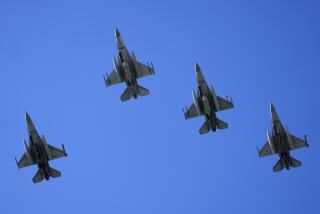Boeing’s tanker tantrum
The yawns that greet stories about the Pentagon’s process of selecting new equipment have, in recent months, been replaced by gasps as the fight over a particular acquisition has played out in the pages of and others. Specifically at issue is the selection of the next generation of aerial refueling tanker -- an intense, nasty political battle over competing aircraft offered by Chicago-based Boeing Co. and the team of Los Angeles-based Northrop Grumman Corp. and EADS, the European parent of Airbus.
In a few weeks, the Pentagon will take the next step in this drawn-out process by issuing a new request for proposals from the two companies. This is the result of the recent decision to cancel the original contract award to Northrop after a Boeing protest uncovered certain relatively minor technical flaws with the way the Air Force analyzed the initial bids.
While I can’t predict the outcome of this next round in the tanker war, I can predict that the period leading up to a new tanker decision will be filled with misinformation. And, if recent history is an indicator, the folks on Boeing’s side of the aisle will generate most of that misinformation.
In my 36-year Air Force career and in my subsequent retirement, I have never before seen a military contractor that is so hell-bent on telling the Air Force and the world that the company and not the Air Force knows what the Air Force needs and wants. Soon we will see more of that.
We’ve already seen some. For example, Boeing and its surrogates insist that when the Air Force selected the Northrop-EADS tanker it was a mistake because that tanker is significantly larger than the plane Boeing is proposing to build. The Boeing side claims a smaller tanker is a more efficient vehicle for the delivery of fuel because you can park more of the smaller planes at bases closer to the action.
This gross oversimplification ignores so many other factors that play into what makes the more efficient fuel delivery tanker. It also ignores the fact that in evaluating the two bids, the Air Force conducted a highly sophisticated, detailed simulation of tanker capability in combat scenarios and the Northrop-EADS plane outperformed Boeing hands down -- a fact that was confirmed by the Government Accountability Office review of Boeing’s bid protest.
In addition, because the Air Force has said it wants a tanker that can double as a carrier of cargo and personnel, the larger Northrop-EADS plane came out ahead because it can carry more of both. In short, the plane the Air Force initially chose is an overall more capable, better-value aircraft.
Another Boeing claim that will be repeated all too often will be that, in this era of high-priced fuel, the Boeing plane should win because it is “24% more fuel efficient” than the competition. That figure, while impressive, is absolute fiction, unsupported by any facts. When the Air Force evaluated the two planes, it calculated the amount of fuel each would consume in performing their main mission -- delivering gas to airplanes. This analysis led to the conclusion that, in fact, the Northrop-EADS plane is the most fuel-efficient.
Using history as a guide, I am confident that Boeing and its friends will completely reject all of those facts and will attempt to fill the air with flak as the new bids are reviewed. I suspect some of Boeing’s flak will land in the ads and news pages of this paper.
My advice to readers is that they ignore all of this. I feel confident that it will be ignored by the Pentagon, as I believe the leadership at the Pentagon will provide the folks who come first, the men and women in the Air Force, the most modern, most capable aerial refueling tanker. If they do, they will once again select Northrop and EADS.
Gen. Charles Horner was the Combined Forces Air Component Commander during Desert Shield and Desert Storm. He consults for a number of defense firms, including Northrop Grumman.
Blowback is an online forum for full-length responses to our articles, editorials and Op-Eds. Click here to read more about Blowback, or submit your own by e-mailing us at opinionla@latimes.com.
More to Read
A cure for the common opinion
Get thought-provoking perspectives with our weekly newsletter.
You may occasionally receive promotional content from the Los Angeles Times.










